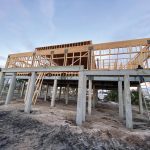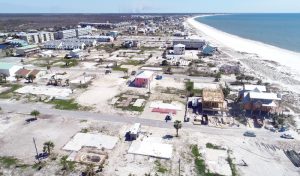Incorporating Resiliency to Coastal Designs in The Florida Panhandle
Hurricane Michael, a Category 5 hurricane, made landfall along the Florida Panhandle on October 10, 2018, with a direct hit between Tyndall Air Force Base and the coastal City of Mexico Beach, leaving a trail of destruction in its path. The damage extended over sixty miles east and west of the eyewall. The areas affected the most experienced sustained winds of 161 miles per hour (mph), a minimum pressure of 919 millibars (mb), and a storm surge reaching 19 feet above sea level with additional wave action well over this elevation. Hurricane Michael was “directly responsible for 16 deaths and about $25 billion in damage in the United States,” according to a report prepared on May 17, 2019, by the National Hurricane Center.
I think most people, including myself, were shocked. How could Mother Nature do so much damage in three hours? We had no idea at the time that the winds were over 160 mph and storm surge was over 17 feet. Seventy years gone in just three hours.
~Mexico Beach Mayor Al Cathey
Upon further investigation of the variation of wind and flood damage in coastal areas like Mexico Beach, Port St. Joe, Cape San Blas, and Bay County, the overwhelming majority of homes built to the current 6th Edition of the Florida Building Code (based off the 2015 IBC), and within the guidelines set forth by the FEMA regulations within the 100-year floodplain and ASCE 7-10, survived the storm with minor to moderate damage. Among the variety of observed failure modes, the most common within structures built utilizing the current Florida Building Code were shear wall failures (ranging from inadequate sheathing thickness to an insufficient number of fasteners), complete lack of shear walls, excessive scouring, and impact from flood and windborne debris. The overall load paths and uplift connections performed very well, confirming that the minimum design parameters and installation methods required by the current Florida Building Code are satisfactory for structural integrity and overall public safety if the design wind event is met. FEMA’s Technical Bulletin 9 establishes a standard for construction of break-away (frangible) structures built below the base flood elevation within the 100-year flood plain. Following Hurricane Michael, it was evident that most structures built in the last 10-15 years, to the specifications recommended in FEMA Technical Bulletin 9, performed as intended during the devastating flood event. In most cases, the ground floor walls designed to be frangible were torn away from the piling supported structures as the storm surge rose and wave action increased. This allowed for the reduction in surface area in which the hydrostatic pressure and velocity driven impact were able to act, reducing the overall lateral load experienced by the pilings supporting the superstructure above.
It was obvious when you walked the streets that the newer building code was successful. Unfortunately, the majority of the houses were older style houses that created a domino effect when the storm surge came, causing extra damage to newer buildings.
~Mayor Cathey
Following Hurricane Michael, local municipalities reacted with resiliency in mind to prepare future structures and developments to withstand the extreme effects of similar storm events. For example, the City of Mexico Beach has amended the pre-Hurricane Michael flood ordinance, which required structures to be elevated above the FEMA 100-year flood plain. The pre-existing flood ordinance required the lowest horizontal structural member (LHSM) to be elevated to a minimum of 1 foot above the FEMA designated 100-year flood elevation within the (VE) flood zone (coastal high hazard area subject to water including wave action). Furthermore, within the VE flood zone designation, all solid walls below the minimum LHSM elevation were required to be break-away (frangible) and were not to exceed 299 square feet of enclosed space. All structures within the AE flood zone designation (stillwater flood elevations and wave effects less than three feet) were required to have the finished floor elevation (FFE) elevated to a minimum of 1 foot above the FEMA designated 100-year flood elevation. There was no limit on the square footage of enclosed space below the FFE elevation within the AE flood zone, and the only requirement was to install flood vents to equalize hydrostatic pressure in the event of a non-velocity flood event. Following Hurricane Michael, the City voted to raise the freeboard to 1.5 feet above the worst-case flood elevation. Within the new ordinance, this is considered to be the maximum of the following: FEMA VE (100-year), FEMA AE (100-year), and FEMA X (500-year).

Performance-based design utilizing a moment frame to maximize openings on a new coastal home in Port St. Joe (Gulf County).
We adopted an eighteen-inch freeboard over the 500-year floodplain. It was hard to ignore what just happened. The Council felt comfortable adding this freeboard to the 500-year floodplain because the only maps we have are the “best available” by FEMA, and these flood elevations are still a work-in-progress. We do not know what the final flood zones will be. I think Mexico Beach did the right thing to try to give property owners the best protection that we could.
~Mayor Cathey
In many cases, the 500-year “X” flood zone designation governs the required FFE and LHSM elevations, requiring some structures to be elevated up to 5-6 feet above the previous flood ordinance requirements. In addition to the new flood ordinance, the City of Mexico Beach increased the minimum design ultimate wind speed to 140 mph as opposed to the 130-mph requirement that was in place before Hurricane Michael. This wind speed requirement is compatible with Gulf County, just to the East of Mexico Beach. Although residents were extremely vocal in their concerns with the changes to the flood ordinance due to the associated increase in construction costs, they were very receptive to the idea of amending the minimum ultimate design wind speed to 140 mph. Additionally, all structures considered to be substantially damaged, as described within FEMA substantial damage guidelines, are required to be either demolished and reconstructed to meet the current codes or undergo improvements to bring the entire structure up to current codes.
What we have in Mexico Beach is remarkable, unlike any other community. Citizens, business owners, frequent tourists, and citizens of surrounding communities showed great resiliency to rebuild the pieces of what was lost and protect what we still have.
~Mayor Cathey
In many cases, performance-based design is implemented in coastal communities and other areas prone to natural disasters like hurricanes. This methodology considers a design approach that will protect the functionality and maintain the intended service and use of structures to continue to meet the needs of the owners and users. In the wake of a natural disaster, the term resiliency becomes a key factor in rebuilding a community. Most property owners that endured the devastation associated with Hurricane Michael want to ensure that, as they rebuild their homes, businesses, and more, all sensible measures are taken to ensure that their investment can withstand a similar storm event. Performance-based design presents the ability to meet the aesthetic and functional demands of homeowners and developers for the intended use of the structure while remaining within the established budget. The designer has the comfort level of providing a conservative design to suit the wants and needs of the Owner, while also preparing for the unknown, whether it be defective building materials, human construction errors, or natural disasters. This is especially important in Hurricane prone regions that are subject to high wind-speeds and velocity storm surge because the damage is unpredictable and highly variable. This approach can be suitably utilized with other climatic hazards as well.
Many of the homeowners and commercial developers have witnessed, firsthand, the destruction that Hurricane Michael left in its path. It is very common to have an Owner ask questions related to the structural stability and overall resiliency of specific building materials as they plan to rebuild. Some simply want to know what siding is best, and some want to know whether to use cast-in-place concrete construction, insulated concrete forms (ICF), or conventional wood-framed construction. Others ask if their proposed structure can be designed to a 180-mph wind-speed. As stated above, the implementation of the existing Florida Building Code, in conjunction with performance-based design, provides a resilient design approach that will produce structures that perform to their intended durability and overall expected life and performance.
The primary concerns with the rebuilding efforts in the areas affected by Hurricane Michael are the availability of contractors, skilled workers, and sub-contractors. It is not uncommon, nearly eighteen months after Hurricane Michael made landfall, for local Builders and General Contractors to have an eighteen- to twenty-four-month backlog before they can begin a new project. Local Planning and Building departments, as well as the Florida Department of Environmental Protection (FDEP) and other coastal permitting agencies, have adjusted in a commendable manner to facilitate the influx in new construction. Within the entire coastal area impacted by Hurricane Michael, residents, as well as municipal and governmental entities, have united to make the best of the situation presented. Each week, more and more homes are being completed, as businesses are also beginning to re-open their doors to provide much-needed services to this community.
Conclusion
Due to the on-going determination and perseverance of the residents and local government agencies within these coastal communities, the Florida panhandle is on its way to rebuilding with the same resiliency that the people of this area have shown time and time again since October 10, 2018.■

